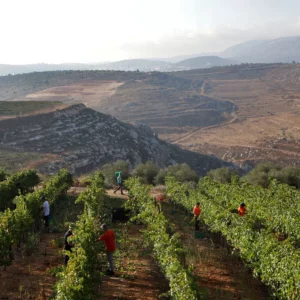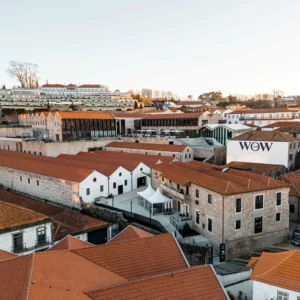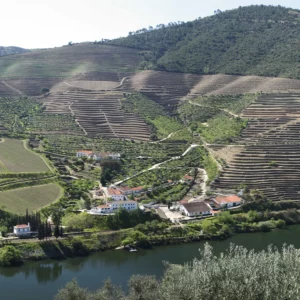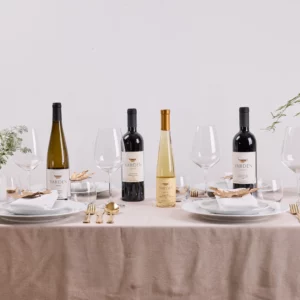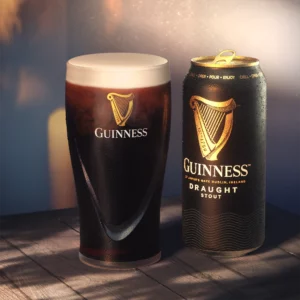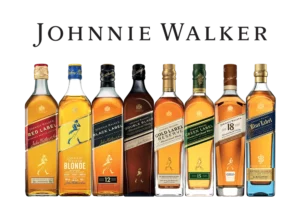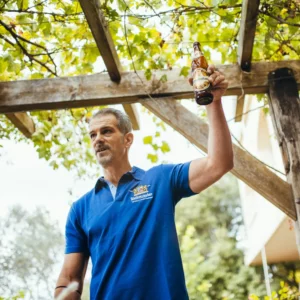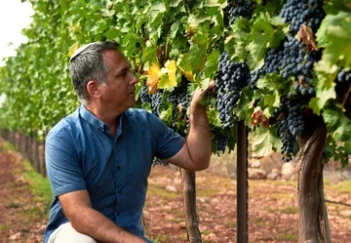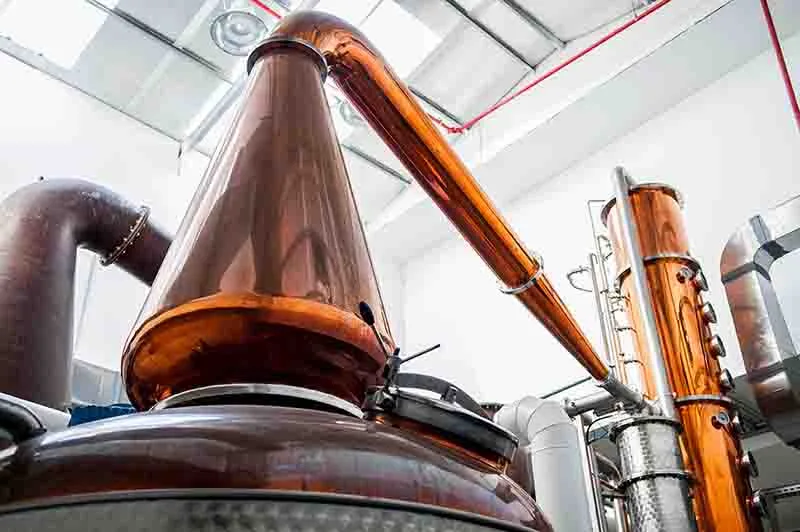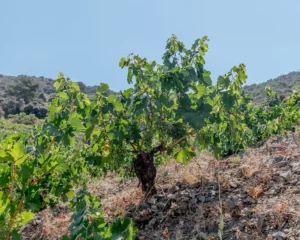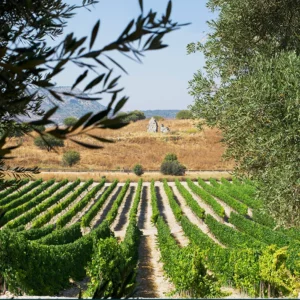I am a Zionist sort of guy. I like supporting Blue & White products. My choice of beer for many years was Goldstar. For 100 years Carmel was the national wine, until Yarden came along. With regard to Israeli spirits, it has always been more difficult to be patriotic. When I came to Israel there were such delights as Lord Gin and Captain Rum. Tehila was the shaky Israeli version of Tequila. Campari Israeli style was known as Kaprei. Araks were not made from grapes, as was the norm, but from imported molasses alcohol. Quality wise, the memory of them makes me cringe.
There were some sporadic successes. In the 1990s there was a time when Carmel?s bottling plant operated 24×6 because of the extraordinary demand of Vodka Stopka in Russia, but this sales bonanza did not last. Israeli brandies (made by Tishbi and Carmel) won some major awards and Sabra (a Seagram liqueur made in Israel) became an original addition to standard range of global liqueurs.
The range of wines increased substantially with the boutique winery revolution that began in the 1990s. The home brewing craze took off in the early 2000s and this led to a new craft brewery boom. Suddenly there were so many more locally produced wines and beers to choose from. In the spirits market, local production virtually fell away, apart from large selling survivors like Elite Arak and Stock 84. The import of global brands and high taxes made the production of local spirits, brandies and liqueurs unprofitable and unviable.
However, the second decade of the 21st century has brought about an artisan, craft distillery boom. Now, there are some producers of high-quality blue and white spirits, many totally original, some using local ingredients. Chief amongst these is the Milk & Honey Distillery in Tel Aviv, Julius Distillery in the Western Galilee, Yerushalmi Distillery in Jerusalem and both the Golan & Pelter Distilleries on the Golan Heights. The first was the artisan Julius Distillery. I have tasted some of their products, which are truly outstanding.?
The largest is the M&H Distillery, whose mission is to bring Israel into the world of Whisky. Whisky is mainly produced in five countries: Scotland, Canada, Japan where it is known as whisky, and Ireland and America, where it is spelt with an ?e?, whiskey. In recent years there have been many new countries making whisky for the first time. The most famous of these is Taiwan. Their Kavalan brand astonished the world by winning some major awards. The hot and humid weather in Taiwan is similar to Israel.
Fast forward to 2012, a few Hi-Tech?ists led by Gal Kalkshtein, dreamt big and decided to bring authentic whisky to the Holy Land. No corners were cut. They employed the late Dr. Jim Swan, one of the most respected gurus of the whisky world, as a consultant. He was the advisor to Kavalan and a specialist in whisky production in hot countries. Tomer Goren, ex brewer, whisky fanatic and now Master Distiller, became the chef. He worked at both Tomintoul and Springbank in Scotland. Springbank is one of my favorite distilleries. It is like a time capsule there, unchanged from a previous age.
The name Milk & Honey could not be more Biblical. The Promised Land was referred to as a Land of Milk & Honey. I have read that in days gone by, before modern quality control, Scots added milk and honey to their whisky to make it more palatable. I do not know if it is true, but as I always say, you shouldn?t spoil a good story by the truth. The first thing you notice is the garish logo. It is of a bull decorated in the blue and black stripes of a bumble bee. Why the bull? ?Well, we tried it with a cow first, but the bull looked better!? was the answer!
I decided to visit them in south Tel Aviv. I arrived at what was once a bakery not far from Jaffa, and within walking distance of the sea. I entered nondescript door and had the feeling that I had entered a nightclub. The visitors? center is in the brand colors. There are colorful graffiti style whisky messages on the walls and a number of workers buzzing about wearing M&H polo shirts. All were young, smiling and they gave a feeling of liveliness and creativity. You certainly felt the spirit and energy of the Israeli start up.
The proof in the pudding was in the eating. When I sat down to taste I was offered one dram aged in a barrel previously used to age pomegranate wine. There was another matured in a barrel in which the C Blanc du Castel (one of our finest Chardonnays) was fermented, and aged sur lies. I immediately felt the creativity and the Israeli penchant for trying something new, pushing the boundaries, experimenting just for the fun of it all. The M&H team is having a ball with their cask specials.
Looking through the glass windows into the distillery, I wondered what I would find. Would it be ?whisky want to be? or a Heath Robinson operation run by amateurs, who were able to talk the talk. I have visited many distilleries in my life, including a week-long tour to Speyside, followed a year later by a visit to Islay and Campbeltown. I am pleased to report that immediately I entered, it felt like an authentic, whisky distillery. It is big compared with other Israeli distilleries, but like a spot on the nose compared to most small distilleries in Scotland.
There were two large pot stills. One, the wash still, was a refugee from Romania of all places. The other, the spirit still, was state of the art from Germany. Ingredients are paramount.? Malted barley comes from England. Peated barley from the Czech Republic. The water is Israeli, but only after it has been treated in their water laboratory. There were casks everywhere; inside, outside, in the corridors, along the walls, almost up the walls. If you landed from outer space, you might think you had arrived in an antique shop specializing in barrels of different origins, shapes and sizes.
They have over 1,500 casks. These include bourbon casks from America, sherry butts from Spain, whisky casks from Scotland and wine barrels from Israel. Most famous is the STR cask, specially developed by Dr. Swan. This is a wine barrel that has been shaved, toasted and then re-charred. It was designed for hot climate maturation, to advance positive flavors and negate the harsh ones. When you enter the official cask room, you are hit by the seductive smell of whisky soaked oak and alcohol. It is like waking up in the center of a brandy-soaked Christmas cake.
The climate is the most significant Israeli effect on the whisky. It can be hot, with a high humidity, particularly on the coast. This accelerates the aging process and could be a problem, but M&H turn it to their advantage. The angel?s share, which is the evaporation, can be as much as 11% in Tel Aviv. Imagine producing a quality, expensive product and signing off 11% before you start. In Scotland, the angel?s share is between 2-4%. Maybe in the Holy Land, the angels are blessed. Being players and tinkerers, M&H are having fun experimenting. Casks are sent for maturation in different micro climates. Some have even been sent to the Dead Sea, the lowest point on earth. Here the angel?s share can be up to 25%! Fortunately for M&H, the whisky ages more quickly and so will not be left there for too long. However, if you are a whisky loving angel, that is clearly the place to be.
M&H has walked a tightrope between gaining respect of the whisky intelligentsia by their authenticity, and at the same showing the Israeli chutzpa, creativity and ingenuity. It seems they have succeeded on both fronts.
In 2017 they launched Israel?s first authentic whisky, matured for three years in cask. In cold climates a malt whisky may be aged for, say, ten years before being released. There are no whisky laws in Israel, so they followed the acceptable norm in Scotland.
I was hosted on my visit by Tal Chotiner, who has done everything in the spirit world. He has been involved in every facet of the spirits and liquor trade and knows the market backwards. He has been a bartender, bar/ restaurant owner, marketer, brand ambassador, educator, consultant, journalist, broadcaster and producer ? and I have probably missed a few. He has experience at every level of operation from an Israeli start up distillery to Diageo, the largest spirit company in the world. M&H is slightly exotic and therefore of interest to whisky geeks. It certainly makes them a whole lot more credible to have someone who is knowledgeable, known and respected representing them in export markets. They export to 20 countries already and have received impressive third party recognition internationally. They are certainly going in a good direction.
The M&H Classic is a 3year old whisky aged in 75% bourbon casks, 20% red wine STR casks and 5% virgin oak. It was light, aperitif style, but not lacking in character. I kept returning to it during the tasting. The aromas were enchanting, if fleeting. Nice sweetness, a little zesty, some citrusy notes, but overall delicate. Certainly, there was more on the nose than flavor, but it was clearly an authentic whisky nonetheless. When I arrived home, I did a comparative blind tasting alongside a 12 year old Scotch malt whisky and the Israeli expression showed very favorably.
I was also pleased to taste the M&H Elements Red Wine Cask whisky. Many moons ago I initiated the idea of Bruichladdich Distillery finishing two whiskies in red wine barrels from Carmel Winery. I still have the Bruichladdich 1989 and 1994, 12 year old, and 1989, 18 year old, with ?additional cask enhancement? of kosher wine casks. They are beautiful whiskies. The Elements Red Wine Cask has floral notes and a definable winey nose and a touch of drying tannin on the finish. The Elements Peated expression was as you expect peaty and smoky. They import casks from Islay for this. It is not medicinal Laphroaig style, nor does the peat over power the other aromas. It is a nice, well balanced dram.
Echoing Macallan in the old halcyon days, but on a rather smaller scale, M&H took the trouble to have kosher Oloroso and Pedro Ximenez sherries made and aged in sherry butts for one year. The Sherry Cask Whisky was my favorite of the Elements. It was slightly richer, with a sweet dried fruit nose and the flavor seemed to have more length than the other whiskies. They tell me this is the first and only malt whisky aged in kosher sherry casks. My favorite of the special expressions was the Cognac Cask. It was warm, complex and had great length. That is something to look forward to.
The M&H Levantine Gin is a wonderful product. It starts like the whisky. The base spirit is 100% malted barley, which is mashed at the distillery and distilled in the pot still. They then add the juniper and botanicals hand sourced from the Lewinsky market in Tel Aviv. These include za?ater, lemon peel, orange, chamomile, lemon verbena, cinnamon and black pepper. These are then distilled for a third time in a small, adorable, almost domestic sized 250 liter pot still. This is not a gin dominated by prominent juniper aromas, which is better for a gin and tonic. It has lifted aromas that should be enjoyed in a balloon glass or drunk in a Martini cocktail. This a super, aromatic Israeli expression of gin.
The Milk and Honey Visitors Center is a great place to visit. A tour, explanation and tasting costs NIS 50. There is also a shop with the full range of products and some M&H souvenirs. Certainly, whisky mavens will be pleasantly surprised by the quality of Israeli whisky. Israelis should be proud of this product, which makes a first-class gift for Hanukkah, Christmas, New Year?s, Novi God or Sylvester?s. Sipping, sharing and savoring the first quality Israeli whisky in 5,000 years, seems a great way to say good riddance to the appalling year of 2020.
Of course, we spit in wine tastings, but they would have looked at me askance if I had done the same to their precious whisky. As we finished the thirteenth glass of the tasting, Chotiner returned to his barman roots and made me an M&H Martini, with Levantine Gin of course. Instead of adding an olive, as accepted international style, he instead drizzled a drop of olive oil into the glass to give it an Israeli slant. Sated, satisfied and very impressed, I was pleased I had a taxi to take me home.
Adam Montefiore is a drinks industry veteran, who has advanced Israeli wine for 35 years. He is known as the English voice of Israeli wine. He is the wine writer for the Jerusalem Post. www.adammontefiore.com



